Arlon, known as “Orolaunum” in Roman times, was an important settlement in the region during the Gallo-Roman period, which spanned from the 1st century BC to the 5th century AD. The city was strategically situated at the intersection of the roads Reims-Trier and Metz-Tongeren and has enjoyed great prosperity during the first centuries of our era, thanks to trade with neighboring regions and as far afield as the Mediterranean. Arlon shares with Tongeren and Tournai the status of the oldest city in Belgium.
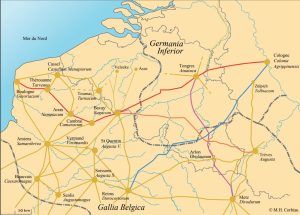
Main roman roads of the Northern Gaul. Source: Les voies romaines par la Wallonie
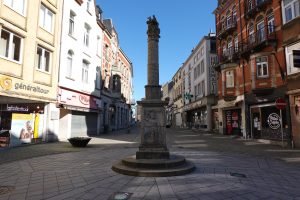
A Roman column erected in the center of Arlon to commemorate its Gallo-roman past. Source: Timetravelrome.
Arlon is home to several Gallo-Roman ruins and sites, each with its unique historical significance.
The Neptune Tower
The Roman Neptune Tower, discovered during excavations in 1948, was part of the rampart built in Roman times. This tower was an integral part of the Gallo-Roman ramparts of the city of Arlon dating from around the year 400. The ramparts had an approximate length of 850 meters and had between 15 and 20 defense towers.
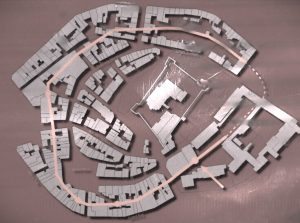
Arlon – Perimeter of ancient defensive walls. Source: Timetravelrome.
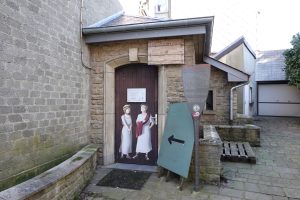
Entrance to the Neptune tower site. Source: Timetravelrome.
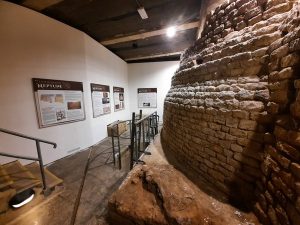
The Neptune tower. Source: arlon.be
The reason the “Neptune” tower bears this name is that a magnificent block representing Neptune and his trident was discovered here. It is preserved in situ, in the heart of the tower’s foundations.

Relief with Neptune. Source: https://www.cirkwi.com/fr/point-interet/179240-tour-romaine-neptune
The Jupiter Tower
The Jupiter Tower was discovered in September 2009 at a distance of approximately 125 meters from the Neptune Tower. The tower is located along rue du Marquisat, on the ground floor of an extension of the Résidence de la Knippchen.
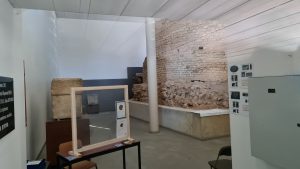
Jupiter Tower in Arlon. Source: Timetravelrome
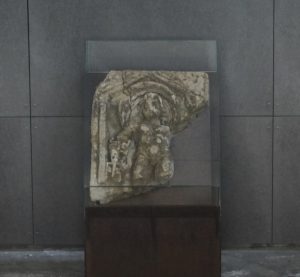
The bas-relief of Jupiter Caelus at the Jupiter Tower. Source: Timetravelrome.
Two other defensive towers are known in Arlon but they are not yet open for visits.
Thermal Baths
The Orolaunum thermal baths were discovered in 1907 when locomotives depot was built on the “Vieux Cimeière” site. The baths had a classic tripartite layout: cold bath (frigidarium), warm bath (tepidarium) and hot bath (caldarium). A religious inscription dedicated to Hercules was also discovered on the site.

The site of the roman baths of Arlon. Source: arlon.be
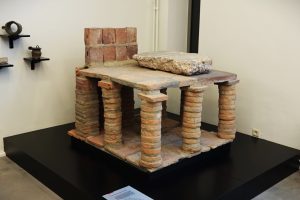
Arlon Archaeological Museum – Hypocaust of the Baths.
The Roman column
In 1972, a drainage contractor discovered a large fragment of a religious monument erected to the glory of Jupiter, the celestial god and protector of families and their possessions. It is usually associated with a coronation featuring a horseman slaying a half-human, half-serpent monster. This type of monument was inspired by a model created in Mainz in honor of Nero. It is assumed to have an octagonal base dedicated to the gods of the week. The column in the Grand’ Rue is a reconstruction made from copies, installed in the early 1990s to evoke the city’s Gallo-Roman past.
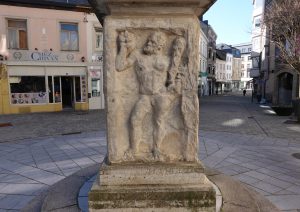
Base of the “Roman column”. Source: Timetravelrome.
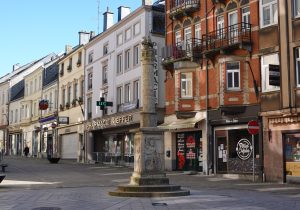
“Roman column” of Arlon. Source: Timetravelrome.
Arlon Archaeological Museum
Founded in 1934, the Musée Archéologique d’Arlon brings together a wealth of Gallo-Roman artefacts discovered in the province of Luxembourg. The Gallo-Roman Lapidary Gallery is the largest of its kind in Belgium, with the best-quality artefacts. It contains more than 425 sculptures from funerary monuments and civic buildings. The remarkable preservation of these sculptures is due to their re-use in the foundations of the rampart built at the end of Antiquity to protect Orolaunum vicus from Germanic invasions. At the end of the third century, Gaul, like the rest of the Roman Empire, experienced great instability, due to the presence of Germanic populations coming from the east. The inhabitants of Orolaunum, who until then had occupied the valley, took refuge on the hill and fortified it. They use stones from cemeteries or civil monuments, cut them, and make the foundations of a defensive wall. These remains are now exhibited in the Archaeological Museum of the city.
Below are a few highlights from the Museum’s collection.
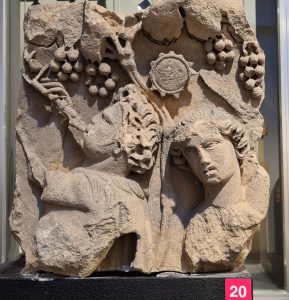
Bacchic procession relief.
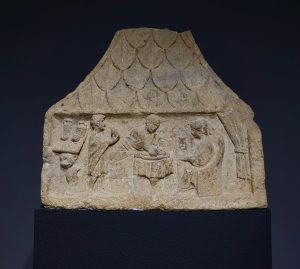
Relief depicting a meal scene in a house. Source: Timetravelrome.
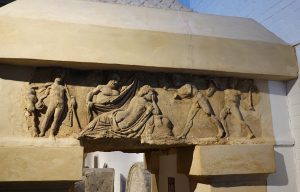
Relief on the mausoleum of Vervicius depicting Ariadne on Naxos uncovered by Silenus on behalf of Bacchus. Source: Timetravelrome.
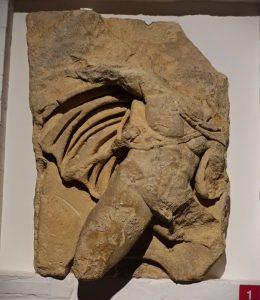
A relief with a warrior found in 1971 on rue de la Caserne. Source: Timetravelrome.
One of the my preferred objects in the Museum of Arlon are spherical-shaped balsamarii found at the necropolis of Hochgericht. I think they really look like Christmas balls.
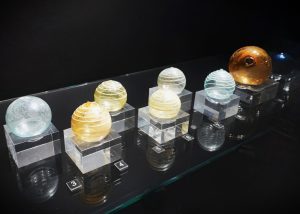
Hochgericht Necropolis spherical balsamarii. Source: Timetravelrome.
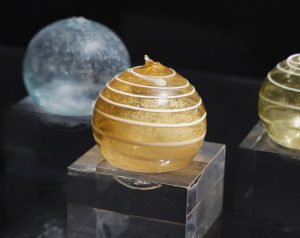
Spherical balsamarium from Hochgericht Necropolis. Source: Timetravelrome.
Another exceptional and probably unique object displayed in the Museum of Arlon is a lead (!) mold used to produce fake coins. It was found in 1898, near Schadeck (Belgian Luxembourg), in a field where remains of a roman building could be seen. The imprint is that of a denarius of Nero. The forty-four imprints were made with the same piece placed successively at forty-four different locations of the mold. It is debatable what metal was used for the production of the fakes – it seems that the only possibility was to produce fake coins using an alloy of lead and tin.
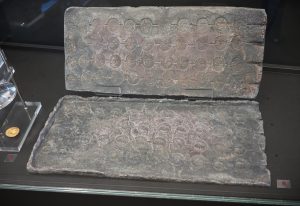
Lead counterfeiting molds -found in 1898 near Schadeck. Source: Timetravelrome.
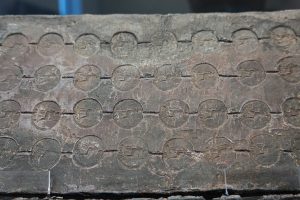
Another foto of the counterfeiting molds. Source: Timetravelrome.
I hope you have enjoyed this little story about the Gallo-roman Arlon and its archaeological museum !
Sources:
Les voies romaines par la Wallonie. La voie Metz-Tongres.
Revue Belge de Numismatique, 1920.
Header picture: Arlon Archaeological Museum – balsamarii found at the Hochgericht Necropolis. Source – Timetravelrome.


